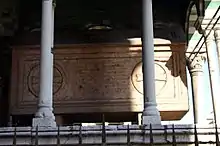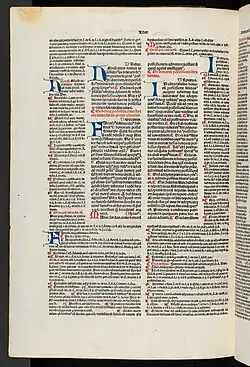Accursius
Accursius[1] (in Italian Accursio or Accorso di Bagnolo; c. 1182 – 1263) was an Italian jurist. He is notable for his organization of the glosses, the medieval comments on Justinian's codification of Roman law, the Corpus Juris Civilis. He was not proficient in the classics, but he was called "the Idol of the Jurisconsults".


Biography
Accursius was born at Impruneta, near Florence. A pupil of Azo, he first practised law in his native city, and was afterwards appointed professor at Bologna, where he had great success as a teacher. He undertook to arrange into one body the tens of thousands of comments and remarks upon the Code, the Institutes and Digests.[2] Accursius assembled from the various earlier glosses for each of these texts a coherent and consistent body of glosses. This compilation, soon given the title Glossa ordinaria or magistralis, and usually known as the Great Gloss,[2] was essentially complete at about 1230. While Accursius was employed in this work, legend has it that, hearing of a similar one proposed and begun by Odofred, another lawyer of Bologna, he feigned indisposition, interrupted his public lectures, and shut himself up, till with the utmost expedition he had accomplished his design.[2]
After the middle of the 13th century, the Gloss had grown to be the starting point for every exegesis of the Corpus Iuris, and was even given force of law in some jurisdictions. The authority of the Gloss is probably due to Accursius' very exhaustive coverage of the civil law, in the course of which he not only pointed out its problems but unlike his predecessors also offered solutions for them.[3] Indeed, modern research has shown that Accursius' work contains nearly 100,000 glosses. The best edition is that of Denis Godefroy, published at Lyon in 1589, in six folio volumes.[2]
Apart from his work as a glossator, Accursius was also engaged very profitably as a legal consultant.
He lived and taught during the later years of his life at Bologna where he died in 1263. It was acknowledged that after his death the legal science in Italy suffered a decline.[4]
Family
Three of his four sons were also jurists: Cervottus, Guilelmus and the noted Franciscus. The latter is buried with his father in one of the arcs lining the street near the Basilica of San Francesco, Bologna.[2] There was a legend that he had a daughter, Accursia, who was also a jurist.[5]
Recognition
For his magnum opus, Accursius was extolled by the lawyers of his own and the immediately succeeding age as the greatest glossator, and he was even called the idol of jurisconsults, but those of later times formed a lower estimate of his merits.[2] Eventually, 16th century humanists, including Rabelais in his Gargantua and Pantagruel, polemically criticised Accursius' Gloss.
Accursius' majestic residence on the Piazza Maggiore was later expanded into the Palazzo Comunale, or the town hall.
- Renaissance editions of Accursius' glosses
--German-_Das_b-uch_des_kaiserlichen_Lehenrecht._-_Lower_cover_(IB6739).jpg.webp) Glossa ordinaria of Accursius
Glossa ordinaria of Accursius Corpus iuris civilis (Digesta Justiniani) with Glossa ordinaria by Accursius
Corpus iuris civilis (Digesta Justiniani) with Glossa ordinaria by Accursius--German-_Das_b-uch_des_kaiserlichen_Lehenrecht._-_Upper_cover_(IB6739).jpg.webp) libre Fedorum by Accursius
libre Fedorum by Accursius Digesta Justiniani Infortiatum by Accursius
Digesta Justiniani Infortiatum by Accursius Digesta Justiniani Infortiatum with Glossa ordinaria by Accursius
Digesta Justiniani Infortiatum with Glossa ordinaria by Accursius Digesta Justiniani with 1495 Gloss by Accursius
Digesta Justiniani with 1495 Gloss by Accursius Digesta Justiniani with 1495 Gloss by Accursius
Digesta Justiniani with 1495 Gloss by Accursius Corpus iuris civilis (Digesta Justiniani) with 1495 Gloss by Accursius
Corpus iuris civilis (Digesta Justiniani) with 1495 Gloss by Accursius
See also
- Cuius est solum eius est usque ad coelum et ad inferos – credited to Accursius[6][7][8][9][10]
- Henry de Bracton
References
- Later sources attribute to him – without a historical basis – the first name of "Franciscus", as well as surnames such as "Bonus" or "Azoninus".
- One or more of the preceding sentences incorporates text from a publication now in the public domain: Chisholm, Hugh, ed. (1911). "Accursius, Franciscus". Encyclopædia Britannica. Vol. 1 (11th ed.). Cambridge University Press. p. 134.
- Weimar, op.cit.
- The Cornell Law Quarterly, Volumes 1-5, p. 437
- Tiraboschi, Girolamo (1823). Storia della letteratura italiana con Indice generale Vol 4. Milan: Società tipografica de' classici italiani. p. 415.
audivi quod Accursius unam filiam habuit, quae actu legebat Bononiae
- Harvard Legal Essays, Written in Honor of and Presented to John Henry Beale and Samuel Williston, 1977, Ayer Company Publishers, Incorporated, p. 522, note 8: "He who owns the soil owns it up to the sky." The maxim had no place in the Roman law during its classical period, but is said to have been first used by Accursius of Bologna, a commentator, who flourished in the thirteenth century. It has been suggested that the maxim was introduced into England by the son of Accursius whom Edward I brought with him on his return from the Holy Land and who for many years held high office under the Crown and also was connected with Oxford University. Bouvé, Private Ownership of Airspace, 1 Air Law Rev. 232, 246–248. At any rate, nearly three centuries later the reporter's note to Bury v. Pope, Cro. Eliz. 118 [78 Eng. Rep. 375] (1587) ascribes the maxim to the time of Edward I."
- Clement Lincoln Bouvé, "Private Ownership of Airspace", 1 Air Law Rev. 232, 376 (1930), 246–248
- "Aeronautics: Sky the Limit?". Time. August 4, 1930. Archived from the original July 15, 2010.
- "A colourful phrase often upon the lips of lawyers since it was first coined by Accursius in Bologna in the 13th century", Justice Griffiths, in Baron Bernstein of Leigh v Skyviews and General Ltd [1978] QB 479, quoted in "Max Headroom: Ownership Of Airspace – Can You Reach For The Stars?", Digging the Dirt, Jon Dickins, Monday, 28 February 2011
- Wilkie, Malcolm & Luxton: Q&A: Land Law 2011 and 2012, Oxford University Press, Chapter 2: Definition of Land Archived June 23, 2011, at the Wayback Machine, p. 5, "Question 1:Cuius est solum, eius est usque ad coelum et ad inferos (the owner of the land owns everything up to the sky and down to the centre of the earth). … Suggested Answer: This maxim, which was coined by Accursius in the thirteenth century, relates to the extent of the ownership enjoyed by the fee simple owner."
- Attribution
 This article incorporates text from a publication now in the public domain: Herbermann, Charles, ed. (1913). "Francesco Accursius". Catholic Encyclopedia. New York: Robert Appleton Company.
This article incorporates text from a publication now in the public domain: Herbermann, Charles, ed. (1913). "Francesco Accursius". Catholic Encyclopedia. New York: Robert Appleton Company.
Further reading
- Weimar, Peter (2001). "Accursius". In Michael Stolleis (ed.). Juristen: ein biographisches Lexikon; von der Antike bis zum 20. Jahrhundert (in German) (2nd ed.). München: Beck. p. 18. ISBN 3-406-45957-9.
- Text of the Glossa ordinaria of Accursius is available online (archived version) in an edition Lyon (Prost, Iullieron) 1627.
External links
- Fiorelli, Piero (1960). "ACCORSO". Dizionario Biografico degli Italiani, Volume 1: Aaron–Albertucci (in Italian). Rome: Istituto dell'Enciclopedia Italiana. ISBN 978-8-81200032-6.
- Francesco Accorso di Bagnolo (Accursius) c. 1182 – 1263.
- Works of Accursius at ParalipomenaIuris